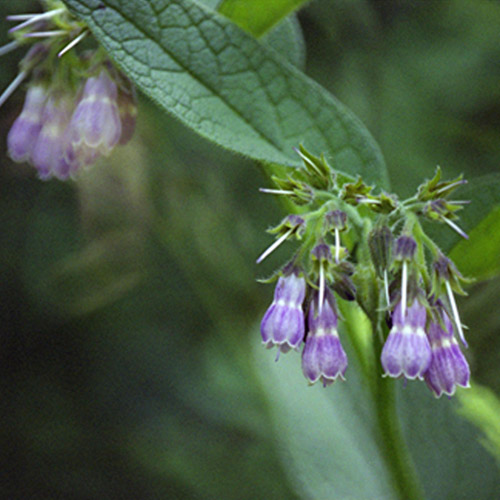|
Home
About Comfrey
Testimonials
About Us
Contact Us
Visit Us On FB

|
 |
-
Common Uses: Bruises * Cuts * Diabetes *
Eczema * Sore throat * Sprains *
-
Properties: Antioxidant* Astringent*
Cancer* Demulcent* Emollient* Expectorant* Vulnerary*
-
Parts Used: root, leaves
-
Constituents: tannin, rosmarinic acid, allantoin,
steroidal saponins, mucilage, inulin, pyrrolizidine alkaloids, gum,
carotene, glycosides, sugars, beta-sitosterol, triterpenoids, vitamin b-12,
protein, zinc.
|
Externally, Comfrey is a wonder when it comes to skin care — it eases swelling
(bruises, sprains, or pulled muscles) and inflammation (diaper rash, varicose
veins and arthritis), and also promotes cell regeneration and healing. Comfrey
is useful in healing stubborn skin ulcers, bedsores, and other lesions. It can
also promote the healing of minor burns, eczema, and psoriasis, treat
athlete’s foot, soothe bee stings, and other insect bites.
Comfrey : Medicinal Uses & Benefits
Comfrey is a marvelous herb and is one of the best-known
healing herbs of all times. Well known and widely used by early Greeks and
Romans, its very name, symphytum, from the Greek symphyo
means to "make grow together", referring to its traditional use of healing
fractures. Comfrey relieves pain and inflammation caused by injuries and
degeneration, especially the symptoms of rheumatoid arthritis and
osteoarthritis. Comfrey creams and oils can be used in arthritic pain
relieving massages.
Comfrey salves, ointments and teas are best know for the
topical treatment of burns, skin ulcerations, abrasions, lacerations, flea and
insect bites, and just about any skin irritation. Comfrey's astringent tannins
form a protective surface over wounds that promotes healing. You may want to
try comfrey or allantoin skin creams for diabetic sores.
Fresh leaves can be applied to bruises, fractures, sprains,
and other injuries. Many healing effects of comfrey are attributable to
allantoin, a compound shown to speed cell production both inside and outside
the body. Comfrey works so fast that many herbalists will add antibacterial
herbs such as goldenseal or thyme to comfrey salves to prevent sealing
bacteria inside a fast healing wound.
Comfrey also has a healing effect on ulcers, and a general
soothing effect on the mucous membranes, making it invaluable in soothing sore
throats and coughs.
In the late 1970s experimental data showed lab rats fed
comfrey 3 to 4 times their body weight over a long period of time developed
liver damage. It would take a human drinking 3 to 4 cups of comfrey tea for
140 years to achieve the same effect, still it must always be considered that
what is safe for the majority can cause allergic reactions in a few.
Herbalists are divided on the use of this age old herb, which has been used
safely for centuries. (use your own judgment and common sense). Most
herbalists limit its use internally to short term applications some say it
should only be applied externally, others point to the fact that a cup of
comfrey contains less cancer causing potential than a can of beer
.
Comfrey Side Effects:
Internal use has become controversial
due to the high content of PAs, however the be herb has been used by both
humans and animals safely for centuries. (use your own judgment and common
sense). Symphytum asperum, Prickly comfrey contains more of the
pyrrolizidine alkaloids (PAs) than the common Symphytum officinale used
in our balm. The most damaging studies are of the isolated extract symphytine, holistic use of the whole herb results in preparations containing
much lower, if any amounts of PAs.
As with any product used internally or externally, consult you physician
before use.
|
|